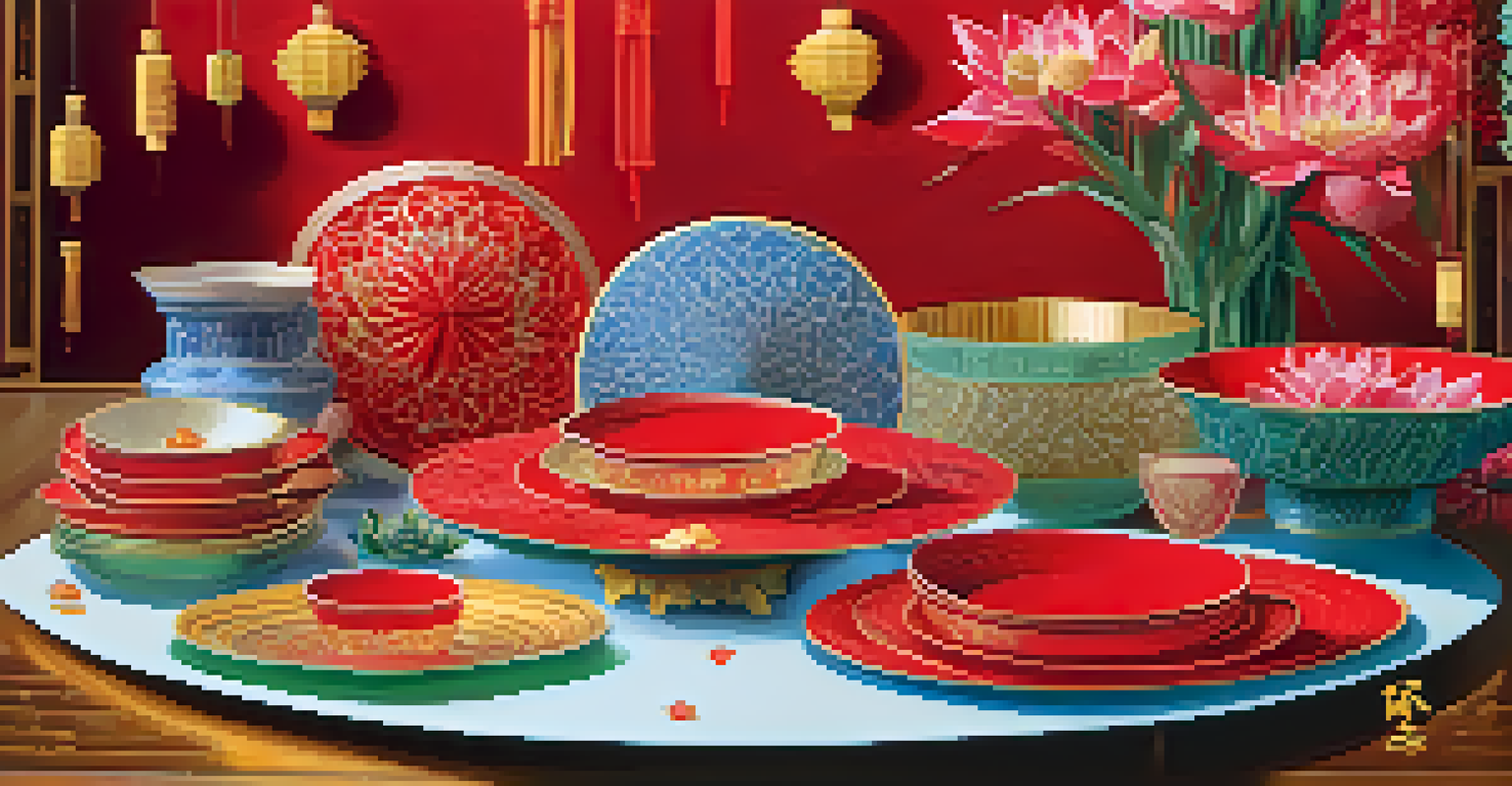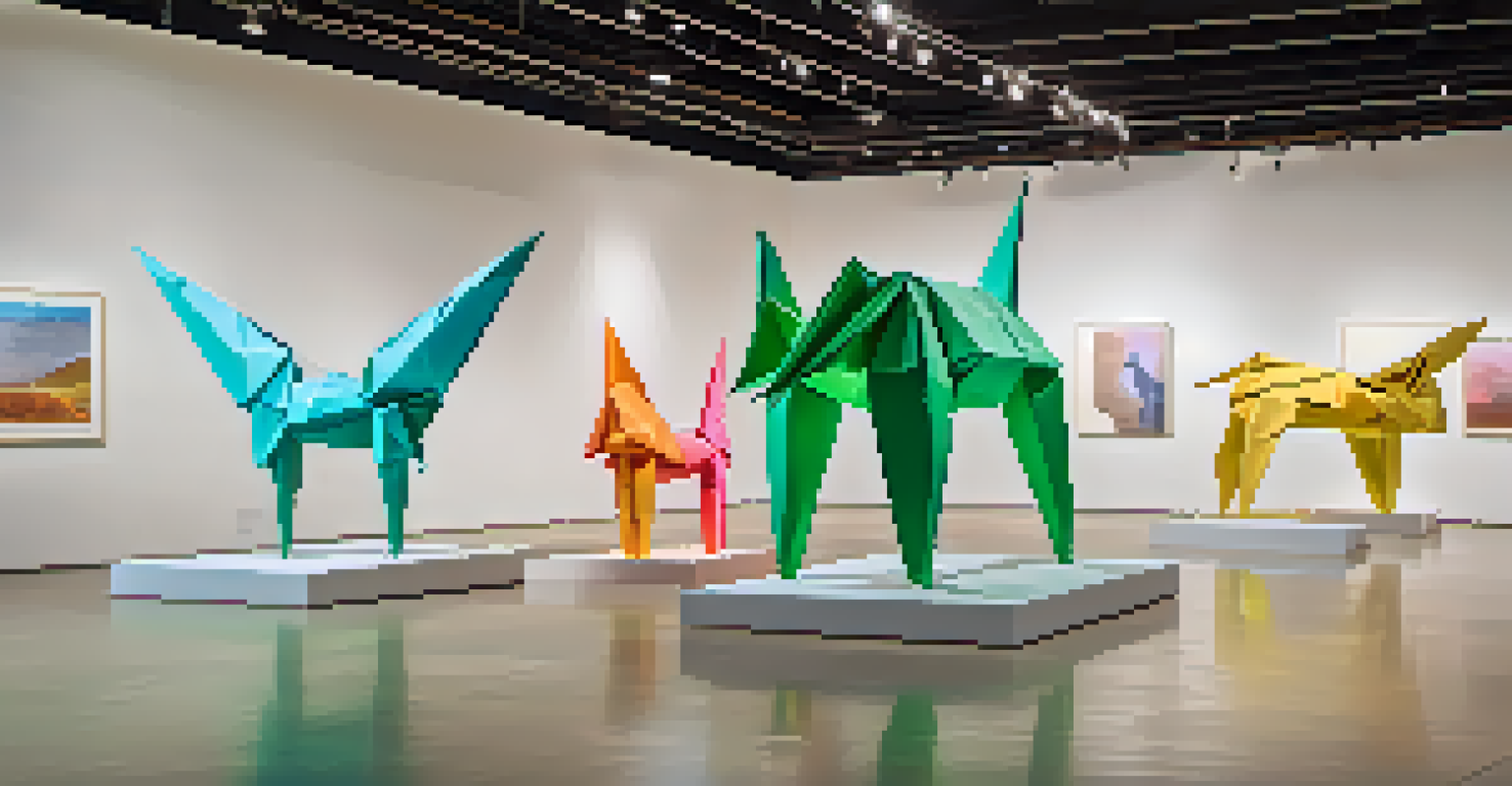Origami Techniques from Around the World: A Global Perspective

The Origins of Origami: A Historical Overview
Origami, the art of paper folding, traces its roots back to ancient Japan, where it initially served ceremonial purposes. This traditional craft soon spread to various cultures, each adding their unique flair. In China, for instance, paper was invented, and its folding techniques evolved into intricate designs used during festivals and celebrations.
Origami is a way of seeing and experiencing the world, transforming a single sheet of paper into a complex representation of life.
As origami traveled through different regions, it adopted local influences, creating a rich tapestry of styles. European artists began to explore this art form in the 19th century, incorporating mathematical principles and artistic expression. Today, origami reflects a blend of history, culture, and creativity, showcasing how a simple piece of paper can transform into a work of art.
Understanding the historical context of origami helps us appreciate its global significance. Each region tells a story through its folds, demonstrating how art transcends boundaries and connects people across cultures.
Japanese Origami: The Traditional Masters
Japan is widely recognized as the birthplace of origami, with its techniques steeped in tradition and artistry. The classic 'kirigami' involves cutting the paper, while 'orisue' focuses purely on folding. This meticulous craft emphasizes patience and precision, allowing artists to create stunning designs, from simple cranes to complex dragons.

Japanese origami often embodies symbols of luck and hope, with the crane being one of the most famous figures. Legend has it that folding a thousand cranes grants the folder a wish, illustrating the cultural significance behind each fold. This spiritual connection adds depth to the practice, transforming it into a meditative art form.
Origami's Rich Cultural Heritage
Origami showcases a blend of history, culture, and creativity, with each region contributing unique styles and significance.
In modern Japan, origami continues to evolve, with contemporary artists pushing the boundaries of traditional techniques. Workshops and exhibitions are popular, inspiring a new generation to embrace this art form while honoring its rich heritage.
Chinese Origami: Celebrating Festivals and Folklore
In China, origami has a vibrant history tied to festivals and folklore. The craft, known as 'zhijia,' has been used for centuries to create decorative pieces for celebrations like the Lunar New Year. Intricate paper designs, such as flowers and animals, play a significant role in traditional celebrations, symbolizing prosperity and good fortune.
The art of folding paper is a conversation between the mind and the hands, creating a bridge between mathematics and artistry.
Chinese origami often incorporates elements of storytelling, with each fold representing a part of a larger narrative. For instance, creating a paper lotus flower can symbolize purity and enlightenment, reflecting deep cultural meanings. This storytelling aspect adds a layer of richness to the art, inviting practitioners to explore their heritage.
Today, Chinese origami continues to thrive, with modern artists blending traditional techniques with contemporary styles. This fusion allows for innovative designs that resonate with both local and global audiences, ensuring the craft remains relevant in today's world.
Western Origami: A Mathematical Approach
In Western countries, origami has gained popularity as a form of artistic expression and mathematical exploration. Artists like Robert Lang and Eric Joisel revolutionized the craft by introducing mathematical principles into their designs. This approach has led to the development of complex models that require a deep understanding of geometry and folding techniques.
Western origami often emphasizes structural integrity and precision, resulting in stunningly intricate designs that can be both artistic and functional. For example, origami is increasingly used in fields like engineering and architecture, showcasing its practical applications beyond mere decoration. This intersection of art and science highlights the versatility of origami as a craft.
Educational Benefits of Origami
Origami serves as an effective educational tool, enhancing students' understanding of math, art, and critical thinking skills.
Workshops and competitions dedicated to Western origami have also emerged, fostering a community of enthusiasts eager to share their passion. This collaborative spirit encourages innovation and experimentation, ensuring that the art form continues to evolve and inspire new generations.
Modern Origami: Innovations and Contemporary Artists
Modern origami has seen a surge in creativity and innovation, with artists pushing the boundaries of what can be achieved with paper. This includes the use of unconventional materials, such as plastic and fabric, expanding the definition of origami beyond traditional paper. Artists like Sipho Mabona and Tomoko Fuse are known for their groundbreaking works that challenge the norms of the craft.
Contemporary origami often incorporates elements from other art forms, such as sculpture and installation art. This fusion creates dynamic pieces that engage viewers in new ways, showcasing the versatility of origami as a medium. For instance, large-scale installations made from folded paper can transform space and invite interaction.
The rise of social media has also played a crucial role in the modern origami movement. Platforms like Instagram and YouTube allow artists to share their work with a global audience, inspiring collaboration and creativity. This connectivity has revitalized the craft, making it accessible to anyone interested in exploring the art of folding.
Origami as Educational Tool: Learning Through Folding
Origami is increasingly recognized as an effective educational tool, teaching concepts in mathematics, art, and even science. By folding paper, students can visualize complex geometric shapes and understand spatial relationships. This hands-on approach makes learning engaging and interactive, fostering a deeper understanding of mathematical principles.
Moreover, origami encourages critical thinking and problem-solving skills. As students work through the steps of a fold, they learn to follow instructions, make decisions, and adapt to challenges. This process builds confidence and creativity, essential skills in today's fast-paced world.
Future Trends Embrace Sustainability
The future of origami focuses on sustainability and innovation, with artists exploring eco-friendly materials and digital tools.
Many educators are now incorporating origami into their curriculums, highlighting its interdisciplinary nature. Workshops and classes focused on origami not only teach the craft but also promote teamwork and collaboration among students, making it a valuable addition to educational settings.
Cultural Significance of Origami: Symbolism and Meaning
Origami is more than just an art form; it carries deep cultural significance around the world. In many cultures, specific folds and designs are imbued with symbolism, representing values such as peace, love, and prosperity. For example, the origami crane symbolizes peace and is often associated with the hope for a better future.
In Japan, the act of folding paper is viewed as a spiritual practice, connecting the artist to their heritage and the natural world. This mindfulness transforms origami into a meditative experience, allowing individuals to find calm and focus through the repetitive motions of folding.

The cultural narratives embedded within origami highlight its role as a medium for storytelling and expression. By exploring the symbolism behind various designs, we can gain insights into the values and beliefs of different cultures, making origami a powerful tool for cultural exchange and understanding.
The Future of Origami: Trends and Sustainability
Looking ahead, the future of origami is bright, with ongoing trends that embrace sustainability and innovation. As environmental concerns grow, many artists are exploring eco-friendly materials, using recycled paper, and even natural fibers to create their designs. This shift towards sustainability not only reflects a commitment to the planet but also inspires creativity in new ways.
Additionally, technology plays a pivotal role in the evolution of origami. Digital tools and software allow artists to experiment with complex designs and share their work with a global community. This technological integration opens up new possibilities for collaboration and creativity, ensuring that origami remains relevant in the modern art landscape.
As we move forward, the blend of tradition and innovation will continue to shape the origami community. With a focus on sustainability and inclusivity, the art of folding will not only preserve its rich heritage but also inspire future generations to explore the endless possibilities of this captivating craft.